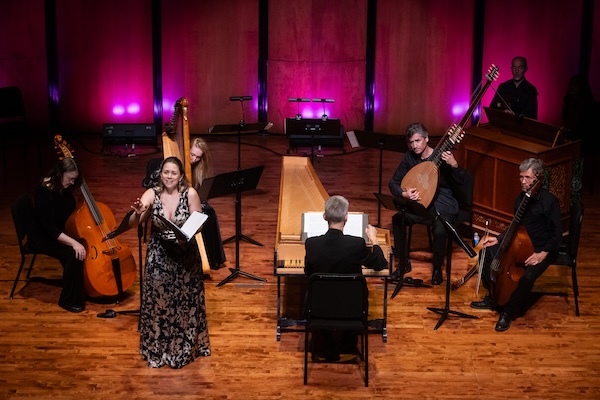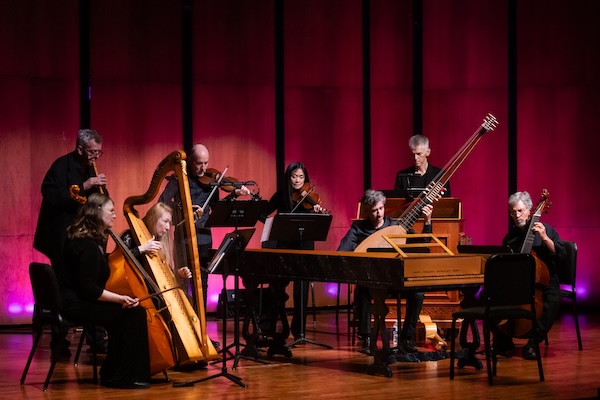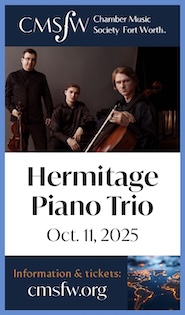Ars Lyrica serves up an enjoyably varied evening of Monteverdi and contemporaries

Claudio Monteverdi’s Madrigals of Love and War receives much admiration but few performances.
Historians hail the work—also known as Monteverdi’s Eighth Book of Madrigals, published in 1638—as a milestone in the birth of Baroque music, emphasizing emotional expression and downplaying the Renaissance’s strict counterpoint.
To Baroque devotees, such as the musicians of Houston’s Ars Lyrica, this is desert-island music, as artistic director Matthew Dirst told Friday’s audience at Hobby Performing Arts Center.
The entire set contains too much music for a single evening in the concert hall (more than three hours worth). Dirst solved the problem by picking out a selection of the madrigals, interspersing instrumental works by Monteverdi’s contemporaries.
The group had showcased a largely different selection from Madrigals of Love and War in 2012. This program offered plenty to show Monteverdi turning the amorous fire of Italian poetry into music bursting with mood-swing vividness and quasi-theatrical power.
Ars Lyrica turned in zesty, colorful performances Friday night. Moving between harpsichord and organ, Dirst led seven instrumentalists and six singers: sopranos Erica Schuller and Amia Langer; countertenor Michael Skarke; tenors Steven Brennfleck and Thomas O’Neill; and bass-baritone Enrico Lagasca.
The first madrigal on the bill was one of the most arresting. In “Hor ch’el ciel e la terra” (“Now that heaven and earth”) the singers enter sotto voce in the lowest parts of their ranges. Hardly moving off their originals pitches, they quietly intone a description of the stillness of the night.
Then the focus turns to a lovelorn man lying awake brooding about “she who is destroying me,” and the voices rouse themselves. At first, they well up in emphatic chords; soon, a tenor briefly cries out alone. When the poetry invokes “a war of anger and grief,” tumult erupts. (Dirst noted from the stage that Madrigals of Love and War invokes war as a metaphor for romantic struggles, not as a literal matter of armies with boots on the ground.)
Ars Lyrica’s singers made the hushes and the outbursts equally telling—blending in the former, ringing out lustily in the latter. That set the tone for the evening.
If the opening number played out in the mind’s eye, “Lamento della Ninfa”—“The Maiden’s Lament”—could have come from one of Monteverdi’s operas. After the tenors and bass set the scene, describing a distraught young woman wandering out of her house at night, a soprano enters and tells a tale of woe about her two-timing lover; her quasi-aria has a plaintive lilt, and the men sometimes chime in sympathetically. Soprano Schuller’s voice was a little unsteady at times, but her pungent sound lent urgency to the maiden’s soliloquy.
Brennfleck, O’Neill and Lagasca delivered the narration simply while adding a few effective touches, such as pulling back to a whisper on the word “sospir,” invoking the heroine’s sighs.
In another opera-ready number, the three men’s animated, agitated singing gave a comic spin to “Gira il nemico insidioso Amore” (“That cunning enemy Cupid is stalking”), a portrait of three men trying to dodge Cupid’s arrows.
The entire group sang buoyantly in the graceful refrain of “Vago augelletto” (“Pretty little bird”), then toned down as the topic turned from the cheery avian to another “poor wretch” afflicted by love. There and in another bird-focused madrigal, “Dolcissimo uscignolo,” sopranos Schuller and Langer’s brightness helped conjure up the leading character.
Ars Lyrica’s instrumentalists supported the singers ably, complementing their delicacy and reinforcing their occasional rowdiness.

The instrumental interludes spotlighted a few of Monteverdi’s less-familiar contemporaries.
Works by Giovanni Paulo Cima and Filippo Vitali—the latter not to be confused with Tomaso Vitali of Chaconne in G minor fame—were attractive vignettes that largely offered brief dashes of counterpoint and easygoing dances.
Two other works boasted more distinctive profiles.
Bartolomeo Montalbano’s Sinfonia quarta, nicknamed “Geloso” after its dedicatee, harkens to operatic scenes as it puts the limelight on a solo instrument—in this case, a recorder played by Paul Leenhouts. Like a character beset by conflicting emotions, the recorder takes off on flights of filigree, then veers into jagged, emphatic outbursts reminiscent of operatic recitative, growing especially fierce at the close.
Leenhouts tackled the theatrics with gusto, and he later played nimbly in Steffano Bernardi’s Sinfonia quarta concertata alongside the equally adroit violinist Stephen Redfield. Bernardi’s music gives the two soloists pride of place amid a larger group, as the program note pointed out, in what amounts to a double concerto—“a genre that had yet to be invented,” Dirst says.
Evidently, Monteverdi wasn’t the only composer looking to the future.
Ars Lyrica performs Renaissance and Baroque music from Hispanic cultures of the Old and New Worlds Dec. 17 at St. Philip Presbyterian Church. arslyricahouston.org
